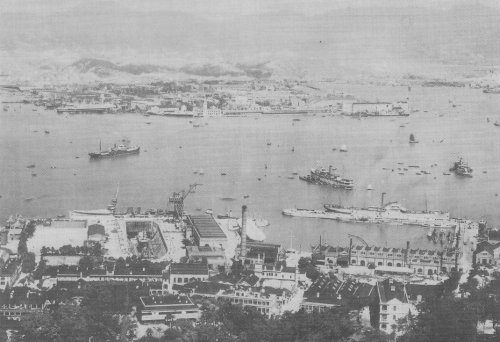- Author
- A.N. Other and NHSA Webmaster
- Subjects
- History - WW2
- Tags
-
- RAN Ships
- None noted.
- Publication
- December 2001 edition of the Naval Historical Review (all rights reserved)
Hong Kong had been the main China Fleet base for most of the early twentieth century with a small but efficient dockyard and drydock constructed on the north of the main island, facing the railway terminus at Tsim Sha Tsui on the end of the Kowloon peninsula at turn of the century. During the thirties the China Fleet had been reduced to a cruiser as flagships and a flotilla of China river gunboats, a squadron of submarines and another of MTBs (although these were occasional periods with an aircraft carrier attached). After a busy war in Europe 1939-41 the naval presence had been reduced to an elderly WWI cruiser, several equally old destroyers and the remaining small warships. By 1941 the naval forces comprised only about 1600 Royal Navy, Royal Marines, and Hong Kong RNVR personnel.

The Japanese declared war on 8 December 1941 by attacking simultaneously at Hawaii (USN Base of Pearl Harbour), Malaya and Hong Kong. Although Churchill himself had declared that Hong Kong was virtually indefensible in face of direct assault from across the land border in China, he had been persuaded by his military advisers to reinforce the Colony at the last moment, in a belief that a longer defence was possible, perhaps until British forces would be on the offensive again in Europe. The landward defence preparations were in hand but there was little that the small naval force could achieve, so on the eve of the Japanese attack, two of the three destroyers were sailed for Singapore, leaving just one, HMS Thracian, together with a large river gunboat HMS Cicala, two smaller ones, and the squadron of six MTBs. The Japanese air attack on RAF Kai Tak destroyed all five remaining aircraft, but the naval forces swung into action to support the army garrison on the mainland. The small armed merchant vessels (auxiliary patrol vessels) manned by the HKRNVR officers and Chinese crews could only be used for patrol purposes and the other refitting craft, HM Ships Robin, Tern, Aldgate, Barlight and RFA tanker Ebonol, were all scuttled. During the Army retreat to Hong Kong Island, the warships gave good fire support to the land forces, intercepted Japanese attempts to cross the harbour in landing craft, destroyed any shipping in the port to avoid it falling into enemy hands and finally evacuated troops to other tactical positions on the island.
The Royal Marines attached to the depot ship HMS Tamar were deployed to assist the land forces, with their commanding officer, Lt Col Giles RM instructing his men to defend the island “…to the last man and last round”. HMS Thracian evacuated some of the 5/7 Rajputs from the Devil’s Peak area while shells and mortars fell all around them, and transported them to Aberdeen, on the south of the island. Meanwhile the naval dockyard was under constant bombardment but was not evacuated. The old wooden depot ship HMS Tamar was taken out of the basin and sunk at a buoy in the harbour on 12th. The Japanese attempted to negotiate a surrender on 13th and again on the 17th but both were firmly refused. A serious attempt to cross the harbour was made by the Japanese on the night of 15 December.
HMS Thracian sailed from Aberdeen into Kowloon Bay, shielded by the darkness against the enemy guns, to intercept junks full of enemy troops. The need to keep close to the shore entailed some risks and she was inadvertently run aground, which caused damage and flooding to her forward compartments. However, she got herself off, then destroyed the junks and was able to return to Aberdeen, where efforts were made by the dockyard staff to dock her there the next evening. The following afternoon an accurate high level bombing attack was made on the Aberdeen dockyard, starting big fires and many casualties, with one near miss slightly damaging Thracian further.
When it was found that the damage caused by grounding could not be repaired, the decision was made to strip Thracian of all armament and early on the 17th she was undocked and steamed round to Repulse Bay, where she was run aground and abandoned on Round Island. Then there was no destroyer. On the night of 18th, after a heavy bombardment, the Japanese landed in strength at several points to the east of the Dockyard and reached the centre of the island by daybreak, having annihilated all opposition. Commodore Collinson ordered five MTBs to attack, destroying a number of troop carrying vessels in the harbour, before being overwhelmed themselves by artillery and aircraft. The last ship to be put out of action was the gunboat HMS Cicala, which had been engaged in sinking the merchant vessels in the harbour. Her crew managed to escape and were engaged ashore a few hours later on the west of the island, as defensive forces began to regroup around Aberdeen, Repulse Bay and Stanley Fort on the south side.




